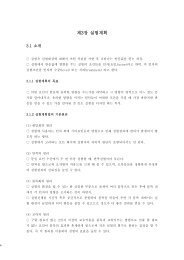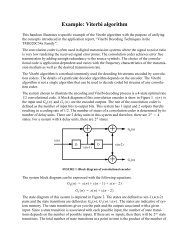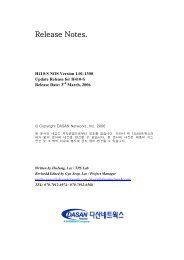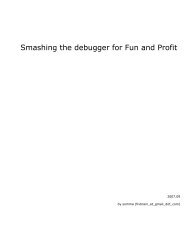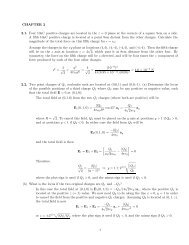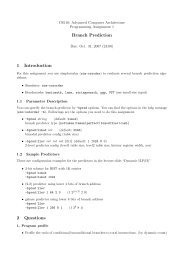"Teaching Smart People How to Learn," by Chris Argyris
"Teaching Smart People How to Learn," by Chris Argyris
"Teaching Smart People How to Learn," by Chris Argyris
- No tags were found...
You also want an ePaper? Increase the reach of your titles
YUMPU automatically turns print PDFs into web optimized ePapers that Google loves.
<strong>Teaching</strong> <strong>Smart</strong> <strong>People</strong><strong>How</strong> <strong>to</strong> <strong>Learn</strong><strong>Chris</strong> <strong>Argyris</strong>4<strong>Chris</strong> <strong>Argyris</strong>James Bryant Conant ProfessorHarvard Business School© 1991 Harvard Business Review.Distributed <strong>by</strong> The New York TimesSpecial Features/Syndication Sales.Any company that aspires <strong>to</strong> succeed in the <strong>to</strong>ugher business environment of the 1990smust rst resolve a basic dilemma: success in the marketplace increasingly dependson learning, yet most people don’t know how <strong>to</strong> learn. What’s more, those members ofthe organization that many assume <strong>to</strong> be the best at learning are, in fact, not very goodat it. I am talking about the well-educated, high-powered, high-commitment professionalswho occupy key leadership positions in the modern corporation.Most companies not only have tremendous difculty addressing this learning dilemma;they aren’t even aware that it exists. The reason: they misunderstand what learningis and how <strong>to</strong> bring it about. As a result, they tend <strong>to</strong> make two mistakes in theirefforts <strong>to</strong> become a learning organization.First, most people dene learning <strong>to</strong>o narrowly as mere ‘‘problem solving,’’ so theyfocus on identifying and correcting errors in the external environment. Solving problemsis important. But if learning is <strong>to</strong> persist, managers and employees must also look inward.They need <strong>to</strong> reect critically on their own behavior, identify the ways they often inadvertentlycontribute <strong>to</strong> the organization’s problems, and then change how they act. Inparticular, they must learn how the very way they go about dening and solving problemscan be a source of problems in its own right.I have coined the terms ‘‘single loop’’ and ‘‘double loop’’ learning <strong>to</strong> capture thiscrucial distinction. To give a simple analogy: a thermostat that au<strong>to</strong>matically turns on theheat whenever the temperature in a room drops below 68 degrees is a good example ofsingle-loop learning. A thermostat that could ask, ‘‘Why am I set at 68 degrees?’’ and thenexplore whether or not some other temperature might more economically achieve the goalof heating the room would be engaging in double-loop learning.Highly skilled professionals are frequently very good at single-loop learning. After all,they have spent much of their lives acquiring academic credentials, mastering one or anumber of intellectual disciplines, and applying those disciplines <strong>to</strong> solve real-world problems.But ironically, this very fact helps explain why professionals are often so bad atdouble-loop learning.Put simply, because many professionals are almost always successful at what theydo, they rarely experience failure. And because they have rarely failed, they have neverlearned how <strong>to</strong> learn from failure. So whenever their single-loop learning strategies gowrong, they become defensive, screen out criticism, and put the ‘‘blame’’ on anyone andeveryone but themselves. In short, their ability <strong>to</strong> learn shuts down precisely at the momentthey need it the most.The propensity among professionals <strong>to</strong> behave defensively helps shed light on thesecond mistake that companies make about learning. The common assumption is thatgetting people <strong>to</strong> learn is largely a matter of motivation. When people have the rightattitudes and commitment, learning au<strong>to</strong>matically follows. So companies focus on creatingnew organizational structures—compensation programs, performance reviews, corporatecultures, and the like—that are designed <strong>to</strong> create motivated and committed employees.But effective double-loop learning is not simply a function of how people feel. It is areection of how they think—that is, the cognitive rules or reasoning they use <strong>to</strong> designVolume 4, Number 2, REFLECTIONS
and implement their actions. Think of these rules as a kind of ‘‘master program’’ s<strong>to</strong>redin the brain, governing all behavior. Defensive reasoning can block learning even whenthe individual commitment <strong>to</strong> it is high, just as a computer program with hidden bugscan produce results exactly the opposite of what its designers had planned.Companies can learn how <strong>to</strong> resolve the learning dilemma. What it takes is <strong>to</strong> makethe ways managers and employees reason about their behavior a focus of organizationallearning and continuous improvement programs. <strong>Teaching</strong> people how <strong>to</strong> reason abouttheir behavior in new and more effective ways breaks down the defenses that block learning.All of the examples that follow involve a particular kind of professional: fast-trackconsultants at major management consulting companies. But the implications of my argumentgo far beyond this specic occupational group. The fact is, more and more jobs—no matter what the title—are taking on the con<strong>to</strong>urs of ‘‘knowledge work.’’ <strong>People</strong> at alllevels of the organization must combine the mastery of some highly specialized technicalexpertise with the ability <strong>to</strong> work effectively in teams, form productive relationships withclients and cus<strong>to</strong>mers, and critically reect on and then change their own organizationalpractices. And the nuts and bolts of management—whether of high-powered consultantsor service representatives, senior managers or fac<strong>to</strong>ry technicians—increasingly consistsof guiding and integrating the au<strong>to</strong>nomous but interconnected work of highly skilledpeople.<strong>Teaching</strong> <strong>Smart</strong> <strong>People</strong> <strong>How</strong> <strong>to</strong> <strong>Learn</strong> · ARGYRIS<strong>How</strong> Professionals Avoid <strong>Learn</strong>ingFor 15 years, I have been conducting in-depth studies of management consultants. I decided<strong>to</strong> study consultants for a few simple reasons. First, they are the epi<strong>to</strong>me of thehighly educated professionals who play an increasingly central role in all organizations.Almost all of the consultants I’ve studied have MBAs from the <strong>to</strong>p three or four U.S.business schools. They are also highly committed <strong>to</strong> theirwork. For instance, at one company, more than 90% of theconsultants responded in a survey that they were ‘‘highlysatised’’ with their jobs and with the company.I also assumed that such professional consultants wouldbe good at learning. After all, the essence of their job is <strong>to</strong>teach others how <strong>to</strong> do things differently. I found, however,that these consultants embodied the learning dilemma. Themost enthusiastic about continuous improvement in theirown organizations, they were also often the biggest obstacle<strong>to</strong> its complete success.As long as efforts at learning and change focused on external organizational fac<strong>to</strong>rs—job redesign, compensation programs, performance review, and leadership training—theprofessionals were enthusiastic participants. Indeed, creating new systems and structureswas precisely the kind of challenge that well-educated, highly motivated professionalsthrived on.And yet the moment the quest for continuous improvement turned <strong>to</strong> the professionals’own performance, something went wrong. It wasn’t a matter of bad attitude. Theprofessionals’ commitment <strong>to</strong> excellence was genuine, and the vision of the company wasclear. Nevertheless, continuous improvement did not persist. And the longer the continuousimprovement efforts continued, the greater the likelihood that they would produceever-diminishing returns.What happened? The professionals began <strong>to</strong> feel embarrassed. They were threatened<strong>by</strong> the prospect of critically examining their own role in the organization. Indeed, becausethey were so well paid (and generally believed that their employers were supportive andfair), the idea that their performance might not be at its best made them feel guilty.Far from being a catalyst for real change, such feelings caused most <strong>to</strong> react defensively.They projected the blame for any problems away from themselves and on<strong>to</strong> whatthey said were unclear goals, insensitive and unfair leaders, and stupid clients.Consider this example. At a premier management consulting company, the managerof a case team called a meeting <strong>to</strong> examine the team’s performance on a recent consultingproject. The client was largely satised and had given the team relatively high marks, butProfessionals embody the learningdilemma: they are enthusiasticabout continuous improvement—and often the biggest obstacle <strong>to</strong>its success.5REFLECTIONS, Volume 4, Number 2
<strong>Teaching</strong> <strong>Smart</strong> <strong>People</strong> <strong>How</strong> <strong>to</strong> <strong>Learn</strong> · ARGYRIS6the manager believed the team had not created the value added that it was capable of andthat the consulting company had promised. In the spirit of continuous improvement, hefelt that the team could do better. Indeed, so did some of the team members.The manager knew how difcult it was for people <strong>to</strong> reect critically on their ownwork performance, especially in the presence of their manager, so he <strong>to</strong>ok a number ofsteps <strong>to</strong> make possible a frank and open discussion. He invited <strong>to</strong> the meeting an outsideconsultant whom team members knew and trusted—‘‘just <strong>to</strong> keep me honest,’’ he said.He also agreed <strong>to</strong> have the entire meeting tape-recorded. That way, any subsequent confusionsor disagreements about what went on at the meeting could be checked againstthe transcript. Finally, the manager opened the meeting <strong>by</strong> emphasizing that no subjectwas off limits—including his own behavior.‘‘I realize that you may believe you cannot confront me,’’ the manager said. ‘‘But Iencourage you <strong>to</strong> challenge me. You have a responsibility <strong>to</strong> tell me where you think theleadership made mistakes, just as I have the responsibility <strong>to</strong> identify any I believe youmade. And all of us must acknowledge our own mistakes. If we do not have an opendialogue, we will not learn.’’The professionals <strong>to</strong>ok the manager up on the rst half of his invitation but quietlyignored the second. When asked <strong>to</strong> pinpoint the key problems in the experience with theclient, they looked entirely outside themselves. The clients were uncooperative and arrogant.‘‘They didn’t think we could help them.’’ The team’s own managers were unavailableand poorly prepared. ‘‘At times, our managers were not up <strong>to</strong> speed before theywalked in<strong>to</strong> the client meetings.’’ In effect, the professionals asserted that they were helpless<strong>to</strong> act differently—not because of any limitations of their own but because of thelimitations of others.The manager listened carefully <strong>to</strong> the team members and tried <strong>to</strong> respond <strong>to</strong> theircriticisms. He talked about the mistakes that he had made during the consulting process.For example, one professional objected <strong>to</strong> the way the manager had run the project meetings.‘‘I see that the way I asked questions closed down discussions,’’ responded themanager. ‘‘I didn’t mean <strong>to</strong> do that, but I can see how you might have believed that I hadalready made up my mind.’’ Another team member complained that the manager hadcaved in <strong>to</strong> pressure from his superior <strong>to</strong> produce the project report far <strong>to</strong>o quickly, consideringthe team’s heavy work load. ‘‘I think that it was my responsibility <strong>to</strong> have saidno,’’ admitted the manager. ‘‘It was clear that we all had an immense amount of work.’’Finally, after some three hours of discussion about his own behavior, the managerbegan <strong>to</strong> ask the team members if there were any errors they might have made. ‘‘Afterall,’’ he said, ‘‘this client was not different from many others. <strong>How</strong> can we be moreeffective in the future?’’The professionals repeated that it was really the clients’ and their own managers’fault. As one put it, ‘‘They have <strong>to</strong> be open <strong>to</strong> change and want <strong>to</strong> learn.’’ The more themanager tried <strong>to</strong> get the team <strong>to</strong> examine its own responsibility for the outcome, the morethe professionals <strong>by</strong>passed his concerns. The best one team member could suggest wasfor the case team <strong>to</strong> ‘‘promise less’’—implying that there was really no way for the group<strong>to</strong> improve its performance.The case team members were reacting defensively <strong>to</strong> protect themselves, even thoughtheir manager was not acting in ways that an outsider would consider threatening. Evenif there were some truth <strong>to</strong> their charges—the clients may well have been arrogant andclosed, their own managers distant—the way they presented these claims was guaranteed<strong>to</strong> s<strong>to</strong>p learning. With few exceptions, the professionals made attributions about the behaviorof the clients and the managers but never publicly tested their claims. For instance,they said that the clients weren’t motivated <strong>to</strong> learn but never really presented any evidencesupporting that assertion. When their lack of concrete evidence was pointed out <strong>to</strong>them, they simply repeated their criticisms more vehemently.If the professionals had felt so strongly about these issues, why had they never mentionedthem during the project? According <strong>to</strong> the professionals, even this was the fault ofothers. ‘‘We didn’t want <strong>to</strong> alienate the client,’’ argued one. ‘‘We didn’t want <strong>to</strong> be seenas whining,’’ said another.The professionals were using their criticisms of others <strong>to</strong> protect themselves from thepotential embarrassment of having <strong>to</strong> admit that perhaps they <strong>to</strong>o had contributed <strong>to</strong> theVolume 4, Number 2, REFLECTIONS
team’s less-than-perfect performance. What’s more, the fact that they kept repeating theirdefensive actions in the face of the manager’s efforts <strong>to</strong> turn the group’s attention <strong>to</strong> itsown role shows that this defensiveness had become a reexive routine. From the professionals’perspective, they weren’t resisting; they were focusing on the ‘‘real’’ causes.Indeed, they were <strong>to</strong> be respected, if not congratulated, for working as well as they didunder such difcult conditions.The end result was an unproductive parallel conversation. Both the manager and theprofessionals were candid; they expressed their views forcefully. But they talked past eachother, never nding a common language <strong>to</strong> describe what had happened with the client.The professionals kept insisting that the fault lay with others. The manager kept trying,unsuccessfully, <strong>to</strong> get the professionals <strong>to</strong> see how they contributed <strong>to</strong> the state of affairsthey were criticizing. The dialogue of this parallel conversation looks like this:Professionals: ‘‘The clients have <strong>to</strong> be open. They must want <strong>to</strong> change.’’Manager: ‘‘It’s our task <strong>to</strong> help them see that change is in their interest.’’Professionals: ‘‘But the clients didn’t agree with our analyses.’’Manager: ‘‘If they didn’t think our ideas were right, how might we have convincedthem?’’Professionals: ‘‘Maybe we need <strong>to</strong> have more meetings with the client.’’Manager: ‘‘If we aren’t adequately prepared and if the clients don’t think we’re credible,how will more meetings help?’’Professionals: ‘‘There should be better communication between case team membersand management.’’Manager: ‘‘I agree. But professionals should take the initiative <strong>to</strong> educate the managerabout the problems they are experiencing.’’Professionals: ‘‘Our leaders are unavailable and distant.’’Manager: ‘‘<strong>How</strong> do you expect us <strong>to</strong> know that if you don’t tell us?’’Conversations such as this one dramatically illustrate the learning dilemma. The problemwith the professionals’ claims is not that they are wrong but that they aren’t useful.By constantly turning the focus away from their own behavior <strong>to</strong> that of others, the professionalsbring learning <strong>to</strong> a grinding halt. The manager understands the trap but doesnot know how <strong>to</strong> get out of it. To learn how <strong>to</strong> do that requires going deeper in<strong>to</strong> thedynamics of defensive reasoning—and in<strong>to</strong> the special causes that make professionals soprone <strong>to</strong> it.<strong>Teaching</strong> <strong>Smart</strong> <strong>People</strong> <strong>How</strong> <strong>to</strong> <strong>Learn</strong> · ARGYRISDefensive Reasoning and the Doom LoopWhat explains the professionals’ defensiveness? Not their attitudes about change or commitment<strong>to</strong> continuous improvement; they really wanted <strong>to</strong> work more effectively. Rather,the key fac<strong>to</strong>r is the way they reasoned about their behavior and that of others.It is impossible <strong>to</strong> reason anew in every situation. If we had <strong>to</strong> think through all thepossible responses every time someone asked, ‘‘<strong>How</strong> are you?’’ the world would pass us<strong>by</strong>. Therefore, everyone develops a theory of action—a set of rules that individuals use<strong>to</strong> design and implement their own behavior as well as <strong>to</strong> understand the behavior ofothers. Usually, these theories of actions become so taken for granted that people don’teven realize they are using them.One of the paradoxes of human behavior, however, is that the master program peopleactually use is rarely the one they think they use. Ask people in an interview or questionnaire<strong>to</strong> articulate the rules they use <strong>to</strong> govern their actions, and they will give you whatI call their ‘‘espoused’’ theory of action. But observe these same people’s behavior, andyou will quickly see that this espoused theory has very little <strong>to</strong> do with how they actuallybehave. For example, the professionals on the case team said they believed in continuousimprovement, and yet they consistently acted in ways that made improvement impossible.When you observe people’s behavior and try <strong>to</strong> come up with rules that would makesense of it, you discover a very different theory of action—what I call the individual’s‘‘theory-in-use.’’ Put simply, people consistently act inconsistently, unaware of the contradictionbetween their espoused theory and their theory-in-use, between the way theythink they are acting and the way they really act.7REFLECTIONS, Volume 4, Number 2
<strong>Teaching</strong> <strong>Smart</strong> <strong>People</strong> <strong>How</strong> <strong>to</strong> <strong>Learn</strong> · ARGYRIS8The very success of professionalsat education helps explain theproblems they have with learning.What’s more, most theories-in-use rest on the same set of governing values. Thereseems <strong>to</strong> be a universal human tendency <strong>to</strong> design one’s actions consistently according<strong>to</strong> four basic values:1. To remain in unilateral control;2. To maximize ‘‘winning’’ and minimize ‘‘losing’’;3. To suppress negative feelings; and4. To be as ‘‘rational’’ as possible —<strong>by</strong> which people mean dening clear objectives andevaluating their behavior in terms of whether or not they have achieved them.The purpose of all these values is <strong>to</strong> avoid embarrassment or threat, feeling vulnerableor incompetent. In this respect, the master program that most people use is profoundlydefensive. Defensive reasoning encourages individuals <strong>to</strong> keep private the premises, inferences,and conclusions that shape their behavior and <strong>to</strong> avoid testing them in a trulyindependent, objective fashion.Because the attributions that go in<strong>to</strong> defensive reasoning are never really tested, it isa closed loop, remarkably impervious <strong>to</strong> conicting points of view. The inevitable response<strong>to</strong> the observation that somebody is reasoning defensively is yet more defensivereasoning. With the case team, for example, whenever anyone pointed out the professionals’defensive behavior <strong>to</strong> them, their initial reaction was <strong>to</strong> look for the cause insomebody else—clients who were so sensitive that they would have been alienated if theconsultants had criticized them or a manager so weak that he couldn’t have taken it hadthe consultants raised their concerns with him. In other words, the case team membersonce again denied their own responsibility <strong>by</strong> externalizing the problem and putting it onsomeone else.In such situations, the simple act of encouraging more open inquiry is often attacked<strong>by</strong> others as ‘‘intimidating.’’ Those who do the attacking deal with their feelings aboutpossibly being wrong <strong>by</strong> blaming the more open individual for arousing these feelingsand upsetting them.Needless <strong>to</strong> say, such a master program inevitably short-circuits learning. And for anumber of reasons unique <strong>to</strong> their psychology, well-educated professionals are especiallysusceptible <strong>to</strong> this.Nearly all the consultants I have studied have stellar academic records. Ironically,their very success at education helps explain the problems they have with learning. Beforethey enter the world of work, their lives are primarily full of successes, so they have rarelyexperienced the embarrassment and sense of threat that comes with failure. As a result,their defensive reasoning has rarely been activated. <strong>People</strong> who rarely experience failure,however, end up not knowing how <strong>to</strong> deal with it effectively. And this serves <strong>to</strong> reinforcethe normal human tendency <strong>to</strong> reason defensively.In a survey of several hundred young consultants at the organizations I have beenstudying, these professionals describe themselves as driven internally <strong>by</strong> an unrealisticallyhigh ideal of performance: ‘‘Pressure on the job is selfimposed.’’‘‘I must not only do a good job; I must also bethe best.’’ ‘‘<strong>People</strong> around here are very bright and hardworking;they are highly motivated <strong>to</strong> do an outstandingjob.’’ ‘‘Most of us want not only <strong>to</strong> succeed but also <strong>to</strong> doso at maximum speed.’’These consultants are always comparing themselveswith the best around them and constantly trying <strong>to</strong> bettertheir own performance. And yet they do not appreciate being required <strong>to</strong> compete openlywith each other. They feel it is somehow inhumane. They prefer <strong>to</strong> be the individualcontribu<strong>to</strong>r—what might be termed a ‘‘productive loner.’’Behind this high aspiration for success is an equally high fear of failure and a propensity<strong>to</strong> feel shame and guilt when they do fail <strong>to</strong> meet their high standards. ‘‘You mustavoid mistakes,’’ said one. ‘‘I hate making them. Many of us fear failure, whether weadmit it or not.’’To the extent that these consultants have experienced success in their lives, they havenot had <strong>to</strong> be concerned about failure and the attendant feelings of shame and guilt. But<strong>to</strong> exactly the same extent, they also have never developed the <strong>to</strong>lerance for feelings offailure or the skills <strong>to</strong> deal with these feelings. This in turn has led them not only <strong>to</strong> fearVolume 4, Number 2, REFLECTIONS
failure but also fear the fear of failure itself. For they know that they will not cope withit superlatively—their usual level of aspiration.The consultants use two intriguing metaphors <strong>to</strong> describe this phenomenon. Theytalk about the ‘‘doom loop’’ and ‘‘doom zoom.’’ Often, consultants will perform well onthe case team, but because they don’t do the jobs perfectly or receive accolades from theirmanagers, they go in<strong>to</strong> a doom loop of despair. And they don’t ease in<strong>to</strong> the doom loop,they zoom in<strong>to</strong> it.As a result, many professionals have extremely ‘‘brittle’’ personalities. When suddenlyfaced with a situation they cannot immediately handle, they tend <strong>to</strong> fall apart. Theycover up their distress in front of the client. They talk about it constantly with their fellowcase team members. Interestingly, these conversations commonly take the form of badmouthingclients.Such brittleness leads <strong>to</strong> an inappropriately high sense of despondency or even despairwhen people don’t achieve the high levels of performance they aspire <strong>to</strong>. Suchdespondency is rarely psychologically devastating, but when combined with defensivereasoning, it can result in a formidable predisposition against learning.There is no better example of how this brittleness can disrupt an organization thanperformance evaluations. Because it represents the one moment when a professional mustmeasure his or her own behavior against some formal standard, a performance evaluationis almost tailor-made <strong>to</strong> push a professional in<strong>to</strong> the doom loop. Indeed a poor evaluationcan reverberate far beyond the particular individual involved<strong>to</strong> spark defensive reasoning throughout an entire organization.At one consulting company, management established anew performance-evaluation process that was designed <strong>to</strong>make evaluations both more objective and more useful <strong>to</strong>those being evaluated. The consultants participated in thePerformance evaluation is tailormade<strong>to</strong> push professionals in<strong>to</strong>the doom loop.design of the new system and in general were enthusiastic because it corresponded <strong>to</strong>their espoused values of objectivity and fairness. A brief two years in<strong>to</strong> the new process,however, it had become the object of dissatisfaction. The catalyst for this about-face wasthe rst unsatisfac<strong>to</strong>ry rating.Senior managers had identied six consultants whose performance they consideredbelow standard. In keeping with the new evaluation process, they did all they could <strong>to</strong>communicate their concerns <strong>to</strong> the six and <strong>to</strong> help them improve. Managers met witheach individual separately for as long and as often as the professional requested <strong>to</strong> explainthe reasons behind the rating and <strong>to</strong> discuss what needed <strong>to</strong> be done <strong>to</strong> improve—but <strong>to</strong>no avail. Performance continued at the same low level and, eventually, the six were let go.When word of the dismissal spread through the company, people responded withconfusion and anxiety. After about a dozen consultants angrily complained <strong>to</strong> management,the CEO held two lengthy meetings where employees could air their concerns.At the meetings, the professionals made a variety of claims. Some said theperformance-evaluation process was unfair because judgments were subjective and biasedand the criteria for minimum performance unclear. Others suspected that the realcause for the dismissals was economic and that the performance-evaluation procedurewas just a g leaf <strong>to</strong> hide the fact that the company was in trouble. Still others arguedthat the evaluation process was antilearning. If the company were truly a learning organization,as it claimed, then people performing below the minimum standard should betaught how <strong>to</strong> reach it. As one professional put it: ‘‘We were <strong>to</strong>ld that the company didnot have an up-or-out policy. Up-or-out is inconsistent with learning. You misled us.’’The CEO tried <strong>to</strong> explain the logic behind management’s decision <strong>by</strong> grounding it inthe facts of the case and <strong>by</strong> asking the professionals for any evidence that might contradictthese facts.Is there subjectivity and bias in the evaluation process? Yes, responded the CEO, but‘‘we strive hard <strong>to</strong> reduce them. We are constantly trying <strong>to</strong> improve the process. If youhave any ideas, please tell us. If you know of someone treated unfairly, please bring itup. If any of you feel that you have been treated unfairly, let’s discuss it now or, if youwish, privately.’’Is the level of minimum competence <strong>to</strong>o vague? ‘‘We are working <strong>to</strong> dene minimumcompetence more clearly,’’ he answered. ‘‘In the case of the six, however, their<strong>Teaching</strong> <strong>Smart</strong> <strong>People</strong> <strong>How</strong> <strong>to</strong> <strong>Learn</strong> · ARGYRIS9REFLECTIONS, Volume 4, Number 2
<strong>Teaching</strong> <strong>Smart</strong> <strong>People</strong> <strong>How</strong> <strong>to</strong> <strong>Learn</strong> · ARGYRIS10performance was so poor that it wasn’t difcult <strong>to</strong> reach a decision.’’ Most of the six hadreceived timely feedback about their problems. And in the two cases where people hadnot, the reason was that they had never taken the responsibility <strong>to</strong> seek out evaluations—and, indeed, had actively avoided them. ‘‘If you have any data <strong>to</strong> the contrary,’’ the CEOadded, ‘‘let’s talk about it.’’Were the six asked <strong>to</strong> leave for economic reasons? No, said the CEO. ‘‘We have morework than we can do, and letting professionals go is extremely costly for us. Do any ofyou have any information <strong>to</strong> the contrary?’’As <strong>to</strong> the company being antilearning, in fact, the entire evaluation process was designed<strong>to</strong> encourage learning. When a professional is performing below the minimumlevel, the CEO explained, ‘‘we jointly design remedial experiences with the individual.Then we look for signs of improvement. In these cases, either the professionals werereluctant <strong>to</strong> take on such assignments or they repeatedly failed when they did. Again, ifyou have information or evidence <strong>to</strong> the contrary, I’d like <strong>to</strong> hear about it.’’The CEO concluded: ‘‘It’s regrettable, but sometimes we make mistakes and hire thewrong people. If individuals don’t produce and repeatedly prove themselves unable <strong>to</strong>improve, we don’t know what else <strong>to</strong> do except dismiss them. It’s just not fair <strong>to</strong> keeppoorly performing individuals in the company. They earn an unfair share of the nancialrewards.’’Instead of responding with data of their own, the professionals simply repeated theiraccusations but in ways that consistently contradicted their claims. They said that a genuinelyfair evaluation process would contain clear and documentable data about performance—butthey were unable <strong>to</strong> provide rsthand examples of the unfairness that theyimplied colored the evaluation of the six dismissed employees. They argued that peopleshouldn’t be judged <strong>by</strong> inferences unconnected <strong>to</strong> their actual performance—but theyjudge management in precisely this way. They insisted that management de ne clear,objective, and unambiguous performance standards—but they argued that any humanesystem would take in<strong>to</strong> account that the performance of a professional cannot be preciselymeasured. Finally, they presented themselves as champions of learning—but they neverproposed any criteria for assessing whether an individual might be unable <strong>to</strong> learn.In short, the professionals seemed <strong>to</strong> hold management <strong>to</strong> a different level of performancethan they held themselves. In their conversation at the meetings, they used manyof the features of ineffective evaluation that they condemned—the absence of concretedata, for example, and the dependence on a circular logic of ‘‘heads we win, tails youlose.’’ It is as if they were saying, ‘‘Here are the features of a fair performance-evaluationsystem. You should abide <strong>by</strong> them. But we don’t have <strong>to</strong> when we are evaluating you.’’Indeed, if we were <strong>to</strong> explain the professionals’ behavior <strong>by</strong> articulating rules thatwould have <strong>to</strong> be in their heads in order for them <strong>to</strong> act the way they did, the rules wouldlook something like this:1. When criticizing the company, state your criticism in ways that you believe arevalid—but also in ways that prevent others from deciding for themselves whetheryour claim <strong>to</strong> validity is correct.2. When asked <strong>to</strong> illustrate your criticisms, don’t include any data that others could use<strong>to</strong> decide for themselves whether the illustrations are valid.3. State your conclusions in ways that disguise their logical implications. If others poin<strong>to</strong>ut those implications <strong>to</strong> you, deny them.Of course, when such rules were described <strong>to</strong> the professionals, they found themabhorrent. It was inconceivable that these rules might explain their actions. And yet indefending themselves against this observation, they almost always inadvertently con-rmed the rules.<strong>Learn</strong>ing <strong>How</strong> <strong>to</strong> Reason ProductivelyIf defensive reasoning is as widespread as I believe, then focusing on an individual’sattitudes or commitment is never enough <strong>to</strong> produce real change. And as the previousexample illustrates, neither is creating new organizational structures or systems. The problemis that even when people are genuinely committed <strong>to</strong> improving their performanceand management has changed its structures in order <strong>to</strong> encourage the ‘‘right’’ kind ofVolume 4, Number 2, REFLECTIONS
ehavior, people still remain locked in defensive reasoning. Either they remain unawareof this fact, or if they do become aware of it, they blame others.There is, however, reason <strong>to</strong> believe that organizations can break out of this viciouscircle. Despite the strength of defensive reasoning, people genuinely strive <strong>to</strong> producewhat they intend. They value acting competently. Their self-esteem is intimately tied upwith behaving consistently and performing effectively. Companies can use these universalhuman tendencies <strong>to</strong> teach people how <strong>to</strong> reason in a new way—in effect, <strong>to</strong> change themaster programs in their heads and thus reshape their behavior.<strong>People</strong> can be taught how <strong>to</strong> recognize the reasoning they use when they design andimplement their actions. They can begin <strong>to</strong> identify the inconsistencies between theirespoused and actual theories of action. They can face up <strong>to</strong>the fact that they unconsciously design and implement actionsthat they do not intend. Finally, people can learn how<strong>to</strong> identify what individuals and groups do <strong>to</strong> create organizationaldefenses and how these defenses contribute <strong>to</strong> anorganization’s problems.Once companies embark on this learning process, theywill discover that the kind of reasoning necessary <strong>to</strong> reduceand overcome organizational defenses is the same kind of‘‘<strong>to</strong>ugh reasoning’’ that underlies the effective use of ideas in strategy, nance, marketing,manufacturing, and other management disciplines. Any sophisticated strategic analysis,for example, depends on collecting valid data, analyzing it carefully, and constantly testingthe inferences drawn from the data. The <strong>to</strong>ughest tests are reserved for the conclusions.Good strategists make sure that their conclusions can withstand all kinds of critical questioning.So <strong>to</strong>o with productive reasoning about human behavior. The standard of analysis isjust as high. Human resource programs no longer need <strong>to</strong> be based on ‘‘soft’’ reasoningbut should be as analytical and as data-driven as any other management discipline.Of course, that is not the kind of reasoning the consultants used when they encounteredproblems that were embarrassing or threatening. The data they collected was hardlyobjective. The inferences they made rarely became explicit. The conclusions they reachedwere largely self-serving, impossible for others <strong>to</strong> test, and as a result, ‘‘self-sealing,’’impervious <strong>to</strong> change.<strong>How</strong> can an organization begin <strong>to</strong> turn this situation around, <strong>to</strong> teach its membershow <strong>to</strong> reason productively? The rst step is for managers at the <strong>to</strong>p <strong>to</strong> examine criticallyand change their own theories-in-use. Until senior managers become aware of how theyreason defensively and the counterproductive consequences that result, there will be littlereal progress. Any change activity is likely <strong>to</strong> be just a fad.Change has <strong>to</strong> start at the <strong>to</strong>p because otherwise defensive senior managers are likely<strong>to</strong> disown any transformation in reasoning patterns coming from below. If professionalsor middle managers begin <strong>to</strong> change the way they reason and act, such changes are likely<strong>to</strong> appear strange—if not actually dangerous—<strong>to</strong> those at the <strong>to</strong>p. The result is an unstablesituation where senior managers still believe that it is a sign of caring and sensitivity <strong>to</strong><strong>by</strong>pass and cover up difcult issues, while their subordinates see the very same actionsas defensive.The key <strong>to</strong> any educational experience designed <strong>to</strong> teach senior managers how <strong>to</strong>reason productively is <strong>to</strong> connect the program <strong>to</strong> real business problems. The best demonstrationof the usefulness of productive reasoning is for busy managers <strong>to</strong> see how itcan make a direct difference in their own performance and in that of the organization.This will not happen overnight. Managers need plenty of opportunity <strong>to</strong> practice the newskills. But once they grasp the powerful impact that productive reasoning can have onactual performance, they will have a strong incentive <strong>to</strong> reason productively not just in atraining session but in all their work relationships.One simple approach I have used <strong>to</strong> get this process started is <strong>to</strong> have participantsproduce a kind of rudimentary case study. The subject is a real business problem that themanager either wants <strong>to</strong> deal with or has tried unsuccessfully <strong>to</strong> address in the past.Writing the actual case usually takes less than an hour. But then the case becomes thefocal point of an extended analysis.For example, a CEO at a large organizational-development consulting company waspreoccupied with the problems caused <strong>by</strong> the intense competition among the variousUntil senior managers becomeaware of the ways they reasondefensively, any change activityis likely <strong>to</strong> be just a fad.<strong>Teaching</strong> <strong>Smart</strong> <strong>People</strong> <strong>How</strong> <strong>to</strong> <strong>Learn</strong> · ARGYRIS11REFLECTIONS, Volume 4, Number 2
<strong>Teaching</strong> <strong>Smart</strong> <strong>People</strong> <strong>How</strong> <strong>to</strong> <strong>Learn</strong> · ARGYRIS12© Emily Sperbusiness functions represented <strong>by</strong> his four direct reports. Not only was he tired of havingthe problems dumped in his lap, but he was also worried about the impact the interfunctionalconicts were having on the organization’s exibility. He had even calculated thatthe money being spent <strong>to</strong> iron out disagreements amounted <strong>to</strong> hundreds of thousands ofdollars every year. And the more ghts there were, the more defensive people became,which only increased the costs <strong>to</strong> the organization.In a paragraph or so, the CEO described a meeting he intended <strong>to</strong> have with his directreports <strong>to</strong> address the problem. Next, he divided the paper in half, and on the right-handside of the page, he wrote a scenario for the meeting—much like the script for a movieor play—describing what he would say and how his subordinates would likely respond.On the left-hand side of the page, he wrote down any thoughts and feelings that he wouldbe likely <strong>to</strong> have during the meeting but that he wouldn’t express for fear they wouldderail the discussion.But instead of holding the meeting, the CEO analyzed this scenario with his directreports. The case became the catalyst for a discussion in which the CEO learned severalthings about the way he acted with his management team.He discovered that his four direct reports often perceived his conversations as counterproductive.In the guise of being ‘‘diplomatic,’’ he would pretend that a consensusabout the problem existed, when in fact none existed The unintended result: instead offeeling reassured, his subordinates felt wary and tried <strong>to</strong> gure out ‘‘what is he reallygetting at.’’The CEO also realized that the way he dealt with the competitiveness among departmentheads was completely contradic<strong>to</strong>ry. On the one hand, he kept urging them <strong>to</strong> ‘‘thinkof the organization as a whole.’’ On the other, he kept calling for actions—departmentbudget cuts, for example—that placed them directly in competition with each other.Finally, the CEO discovered that many of the tacit evaluations and attributions hehad listed turned out <strong>to</strong> be wrong. Since he had never expressed these assumptions, hehad never found out just how wrong they were. What’s more, he learned that much ofwhat he thought he was hiding came through <strong>to</strong> his subordinates anyway—but with theadded message that the boss was covering up.The CEO’s colleagues also learned about their own ineffective behavior. They learned<strong>by</strong> examining their own behavior as they tried <strong>to</strong> help the CEO analyze his case. Theyalso learned <strong>by</strong> writing and analyzing cases of their own. They began <strong>to</strong> see that they <strong>to</strong>otended <strong>to</strong> <strong>by</strong>pass and cover up the real issues and that the CEO was often aware of it butdid not say so. They <strong>to</strong>o made inaccurate attributions and evaluations that they did notexpress. Moreover, the belief that they had <strong>to</strong> hide important ideas and feelings from theCEO and from each other in order not <strong>to</strong> upset anyone turned out <strong>to</strong> be mistaken. In thecontext of the case discussions, the entire senior management team was quite willing <strong>to</strong>discuss what had always been undiscussable.In effect, the case study exercise legitimizes talking about issues that people havenever been able <strong>to</strong> address before. Such a discussion can be emotional—even painful.But for managers with the courage <strong>to</strong> persist, the payoff is great: management teams andentire organizations work more openly and more effectively and have greater options forbehaving exibly and adapting <strong>to</strong> particular situations.When senior managers are trained in new reasoningskills, they can have a big impact on the performance ofthe entire organization—even when other employees arestill reasoning defensively. The CEO who led the meetingson the performance-evaluation procedure was able <strong>to</strong> defusedissatisfaction because he didn’t respond <strong>to</strong> professionals’criticisms in kind but instead gave a clearpresentation of relevant data. Indeed, most participants<strong>to</strong>ok the CEO’s behavior <strong>to</strong> be a sign that the companyreally acted on the values of participation and employeeinvolvement that it espoused.Of course, the ideal is for all the members of an organization<strong>to</strong> learn how <strong>to</strong> reason productively. This hashappened at the company where the case team meeting<strong>to</strong>ok place. Consultants and their managers are now ableVolume 4, Number 2, REFLECTIONS
<strong>to</strong> confront some of the most difcult issues of the consultant-client relationship. To geta sense of the difference productive reasoning can make, imagine how the original conversationbetween the manager and case team might have gone had everyone engaged ineffective reasoning. (The following dialogue is based on actual sessions I have attendedwith other case teams at the same company since the training has been completed.)First, the consultants would have demonstrated their commitment <strong>to</strong> continuous improvement<strong>by</strong> being willing <strong>to</strong> examine their own role in the difculties that arose duringthe consulting project. No doubt they would have identied their managers and the clientsas part of the problem, but they would have gone on <strong>to</strong> admit that they had contributed<strong>to</strong> it as well. More important, they would have agreed with the manager that as theyexplored the various roles of clients, managers, and professionals, they would make sure<strong>to</strong> test any evaluations or attributions they might make against the data. Each individualwould have encouraged the others <strong>to</strong> question his or her reasoning. Indeed, they wouldhave insisted on it. And in turn, everyone would have unders<strong>to</strong>od that act of questioningnot as a sign of mistrust or an invasion of privacy but as a valuable opportunity forlearning.The conversation about the manager’s unwillingness <strong>to</strong> say no might look somethinglike this:Professional #1: ‘‘One of the biggest problems I had with the way you managed thiscase was that you seemed <strong>to</strong> be unable <strong>to</strong> say no when either the client or your superiormade unfair demands.’’ [Gives an example.]Professional #2: ‘‘I have another example <strong>to</strong> add. [Describes a second example.] ButI’d also like <strong>to</strong> say that we never really <strong>to</strong>ld you how we felt about this. Behind your backwe were bad-mouthing you—you know, ‘he’s being such a wimp’—but we never cameright out and said it.’’Manager: ‘‘It certainly would have been helpful if you had said something. Was thereanything I said or did that gave you the idea that you had better not raise this with me?’’Professional #3: ‘‘Not really. I think we didn’t want <strong>to</strong> sound like we were whining.’’Manager: ‘‘Well, I certainly don’t think you sound like you’re whining. But twothoughts come <strong>to</strong> mind. If I understand you correctly, you were complaining, but thecomplaining about me and my inability <strong>to</strong> say no was covered up. Second, if we haddiscussed this, I might have gotten the data I needed <strong>to</strong> be able <strong>to</strong> say no.’’Notice that when the second professional describes how the consultants had coveredup their complaints, the manager doesn’t criticize her. Rather, he rewards her for beingopen <strong>by</strong> responding in kind. He focuses on the ways that he <strong>to</strong>o may have contributed <strong>to</strong>the cover-up. Re ecting undefensively about his own role in the problem then makes itpossible for the professionals <strong>to</strong> talk about their fears of appearing <strong>to</strong> be whining. Themanager then agrees with the professionals that they shouldn’t become complainers. Atthe same time, he points out the counterproductive consequences of covering up theircomplaints.Another unresolved issue in the case team meeting concerned the supposed arroganceof the clients. A more productive conversation about that problem might go like this:Manager: ‘‘You said that the clients were arrogant and uncooperative. What did theysay and do?’’Professional #1: ‘‘One asked me if I had ever met a payroll. Another asked how longI’ve been out of school.’’Professional #2: ‘‘One even asked me how old I was!’’Professional #3: ‘‘That’s nothing. The worst is when they say that all we do is interviewpeople, write a report based on what they tell us, and then collect our fees.’’Manager: ‘‘The fact that we tend <strong>to</strong> be so young is a real problem for many of ourclients. They get very defensive about it. But I’d like <strong>to</strong> explore whether there is a wayfor them <strong>to</strong> freely express their views without our getting defensive.‘‘What troubled me about your original responses was that you assumed you wereright in calling the clients stupid. One thing I’ve noticed about consultants—in this companyand others—is that we tend <strong>to</strong> defend ourselves <strong>by</strong> bad-mouthing the client.’’Professional #1: ‘‘Right. After all, if they are genuinely stupid, then it’s obviously no<strong>to</strong>ur fault that they aren’t getting it!’’Professional #2: ‘‘Of course, that stance is antilearning and overprotective. By assumingthat they can’t learn, we absolve ourselves from having <strong>to</strong>.’’<strong>Teaching</strong> <strong>Smart</strong> <strong>People</strong> <strong>How</strong> <strong>to</strong> <strong>Learn</strong> · ARGYRIS13REFLECTIONS, Volume 4, Number 2
<strong>Teaching</strong> <strong>Smart</strong> <strong>People</strong> <strong>How</strong> <strong>to</strong> <strong>Learn</strong> · ARGYRISProfessional #3: ‘‘And the more we all go along with the bad-mouthing, the more wereinforce each other’s defensiveness.’’Manager: ‘‘So what’s the alternative? <strong>How</strong> can we encourage our clients <strong>to</strong> expresstheir defensiveness and at the same time constructively build on it?’’Professional #1: ‘‘We all know that the real issue isn’t our age; it’s whether or not weare able <strong>to</strong> add value <strong>to</strong> the client’s organization. They should judge us <strong>by</strong> what weproduce. And if we aren’t adding value, they should get rid of us—no matter how youngor old we happen <strong>to</strong> be.’’Manager: ‘‘Perhaps that is exactly what we should tell them.’’In both these examples, the consultants and their manager are doing real work. Theyare learning about their own group dynamics and addressing some generic problems inclient-consultant relationships. The insights they gain will allow them <strong>to</strong> act more effectivelyin the future—both as individuals and as a team. They are not just solving problemsbut developing a far deeper and more textured understanding of their role as members ofthe organization. They are laying the groundwork for continuous improvement that istruly continuous. They are learning how <strong>to</strong> learn.Commentary<strong>by</strong> <strong>Chris</strong> <strong>Argyris</strong>14We are inundated with examples of the defensive reasoning and organizational defensive routinesthat this article describes. There is Enron, Arthur Andersen, the CIA, the FBI, the Catholic hierarchy,and the administration of school systems.Several questions come <strong>to</strong> mind that I think are relevant. Enron and Andersen have receivedawards for leadership and enlightened human resource programs. In both organizations, the <strong>to</strong>pmanagement genuinely championed these programs. Yet the same <strong>to</strong>p executives violated the tenetsof the old programs. Do we have theories that will not only explain the ip-ops, but predictwhen they will occur and how <strong>to</strong> prevent them?<strong>How</strong> is it that the church hierarchies, which espouse trust and honesty, skillfully producecover-ups and cover-up of the cover-ups? <strong>How</strong> do we explain that educational leaders cover upteacher incompetence <strong>by</strong> giving answers <strong>to</strong> students so that they can pass prociency tests?Finally, how do we explain that the ‘‘local’’ levels of the FBI feel free <strong>to</strong> assign responsibilityfor problems, when later they admit that they create the same problems at the local level andcovered up that this is the case?Another question focuses on the fact that most organizational change programs are based onemulating best practices. The Achilles heel of this strategy is that what creates the best practicescan also harbor processes that eventually bring them down. For example, 3M has for years been<strong>to</strong>uted as an innovative company. We now learn that this is no longer the case. <strong>How</strong> did this happen?Could the deterioration have been avoided?Finally, there is the question about our competence <strong>to</strong> produce the claims that we espouse. Ina recent inquiry, I found that many professionals, when being challenged, respond with the samebehaviors for which they criticized line managers. Moreover, many of the programs were not implementable,and their crea<strong>to</strong>rs appeared skillfully unaware of the inconsistencies (<strong>Argyris</strong>, 2000).Reference<strong>Argyris</strong>, C. Flawed Advice and the Management Trap (New York: Oxford University Press, 2000).Commentary<strong>by</strong> Haridimos TsoukasVulnerability, Moral Responsibility, and Reexive ThinkingWhen <strong>Chris</strong> <strong>Argyris</strong> published his now classic article, the terms ‘‘knowledge work’’ and the‘‘knowledge-based organization’’ had not yet fully entered public discourse <strong>to</strong> the extent that theyhave <strong>to</strong>day. <strong>Argyris</strong>, however, was prescient enough <strong>to</strong> realize that the kind of ‘‘smart people’’ hewas writing about were not the exception: in the advanced economies, they were becoming theVolume 4, Number 2, REFLECTIONS
norm. Knowledge workers, or symbolic analysts, have been the fastest growing group of employees(at least, in the US; Barley, 1996).<strong>Argyris</strong>’s argument about the inherent difculty smart people have in engaging in double-loop(or reexive) learning is particularly relevant <strong>to</strong>day, as we are moving from the classic Weberianbureaucracy <strong>to</strong> post-bureaucratic forms of organization or, <strong>to</strong> use a different language, from themodern <strong>to</strong> the post-modern rm (Heckscher and Donnellon, 1994). Here is, I think, how <strong>Argyris</strong>’sinsights enrich those of other organizational psychologists, such as Larry Hirschhorn (1997), and ofsociologists, such as Shoshana Zuboff (1988) and Anthony Giddens (1991). For Hirschhorn, what isparticularly distinctive in the shift <strong>to</strong> the post-modern organization is a change in the very concep<strong>to</strong>f personhood: individuals increasingly rely less on internalizing organizational authority as represented<strong>by</strong> the boss; instead, they rely more on internalized images of themselves, on their ownpersonal authority.What this means is that, in the post-modern organization, individuals bring more of themselves(their ideas, their feelings) <strong>to</strong> their work. In Hirschhorn’s (1997: 9) terms, ‘‘they are morepsychologically present.’’ A post-modern rm—a rm that is rich in information and relies heavilyon the daily choices of its knowledgeable employees —is a place that, unlike the modern rm,thrives on doubt and challenge. As organizational ethnographers, such as Julian Orr (1996) andEtienne Wenger (1998), have shown, daily work in information-rich companies is more decisionintensive—more loci for decision making <strong>by</strong> employees are created. The more ‘‘informated’’ (<strong>to</strong> useZuboff’s term) a workplace is, the more decisions employees will have <strong>to</strong> make. Or, <strong>to</strong> put it differently,the more informated a workplace is, the more reexive the organization is capable of becoming(what Giddens calls ‘‘institutional reexivity’’); it has the opportunity <strong>to</strong> feed back, andreect on, the information about its modus operandi and the outcomes it brings about.In such organizations, individuals need <strong>to</strong> be able <strong>to</strong> ask critical questions of others and ofthemselves if they are <strong>to</strong> be effective in fully reaping the potential benets reexivity brings about.Individuals, therefore, no longer need <strong>to</strong> uphold the ‘‘masculine ideal’’—that is, <strong>to</strong> suppress doubtand ambivalence. On the contrary, doubt, debate, and reexivity are the very qualities needed <strong>to</strong>promote learning. A knowledge-intensive workplace thrives on the exchange of ideas and experiencesin the interest of enhancing the collective pool of knowledge and of generating new ideas.But, as we know from academic life, for ideas <strong>to</strong> ourish, debate is needed; hence, the importanceof criticism, learning, and reexivity.Throughout his work, <strong>Argyris</strong> has pointed out the difculties practitioners have in engaging inreexive thinking —in his terms, in ‘‘double-loop thinking.’’ This is particularly so in the case ofknowledge workers because, <strong>to</strong> the extent they are more psychologically present at work, they exposemore of themselves <strong>to</strong> others; hence, they are more vulnerable. <strong>Argyris</strong> documents this vulnerabilityin his article, showing the defensive reasoning it brings out in knowledge workers. Morethan that, however, he shows what individuals need <strong>to</strong> do in order <strong>to</strong> s<strong>to</strong>p being defensive whenthe spotlight is turned on themselves— how <strong>to</strong> engage in productive reasoning. The message <strong>Argyris</strong>is getting across, it seems <strong>to</strong> me, is not only how productive reasoning may be achieved but,also, the importance of constantly challenging yourself, of expanding your horizons, of ‘‘knowingthyself.’’In other words, <strong>Argyris</strong> invites knowledge workers <strong>to</strong> undertake a primarily moral, not justtechnical, task: <strong>to</strong> be open <strong>to</strong> criticism, <strong>to</strong> be willing <strong>to</strong> test their claims publicly against evidence,<strong>to</strong> accept that they <strong>to</strong>o are partly responsible for the problems they are confronted with. The clientmay or may not be ‘‘stupid,’’ but the real question, if a consultant is really keen on learning, is‘‘what can I do <strong>to</strong> improve the relationship with the client (or my boss, or anyone else)?’’ It allcomes down <strong>to</strong> individual responsibility, and this is, essentially, a moral issue. In that sense, as wellas being an inuential organizational psychologist and an implicit moral philosopher, <strong>Argyris</strong> is asystemic theorist, not <strong>to</strong>o different from his own hero Gregory Bateson (1979): we partly createthe problems we face, he says, and we have a responsibility for this. An excellent point.Haridimos TsoukasGeorge D. Mavros ResearchProfessor in Organization andManagementALBA, GreeceProfessor of Organization Theoryand BehaviorUniversity of StrathclydeGraduate School of Business, UKhtsoukas@alba.edu.gr<strong>Teaching</strong> <strong>Smart</strong> <strong>People</strong> <strong>How</strong> <strong>to</strong> <strong>Learn</strong> · ARGYRIS15ReferencesBarley, S. The New World of Work (London: British-North American Committee, 1996): 59.Bateson, G. Mind and Nature (Toron<strong>to</strong>: Bantam, 1979).Giddens, A. Modernity and Self-Identity (Cambridge, UK: Polity Press, 1991).Heckscher, C. and A. Donnellon. The Post-Bureaucratic Organization, (London: Sage, 1994).Hirschhorn, L. Reworking Authority (Cambridge, MA: MIT Press, 1997).Orr, J. Talking About Machines (Ithaca, NY: ILR Press/Cornell University Press, 1996).Wenger, E. Communities of Practice (Cambridge: Cambridge University Press, 1998).Zuboff, S. In the Age of the <strong>Smart</strong> Machine (Oxford: Heinemann, 1988).REFLECTIONS, Volume 4, Number 2


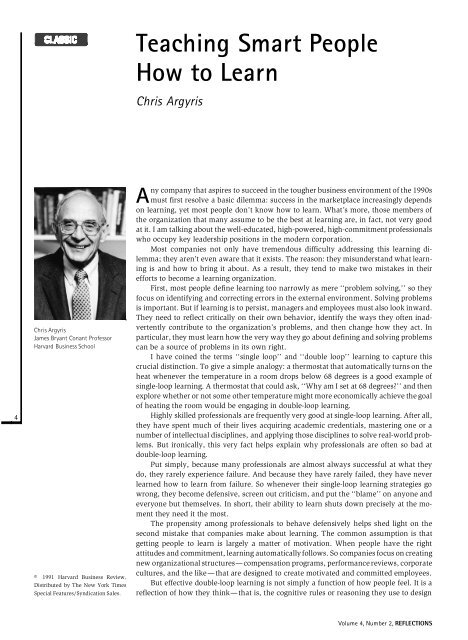

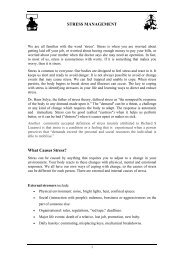

![Finale 2006 - [autumn leaves.MUS]](https://img.yumpu.com/46046993/1/184x260/finale-2006-autumn-leavesmus.jpg?quality=85)
